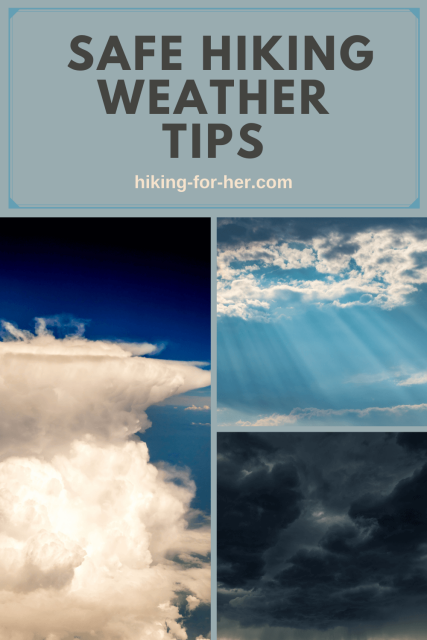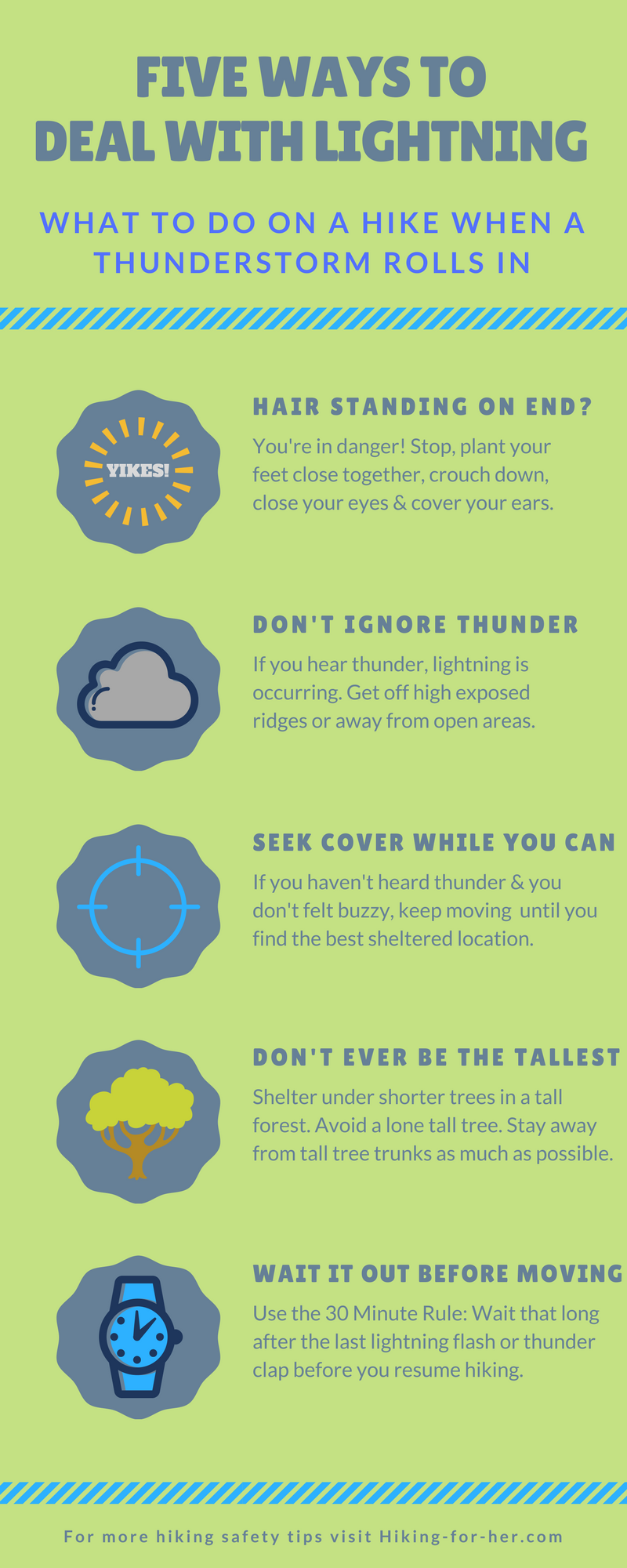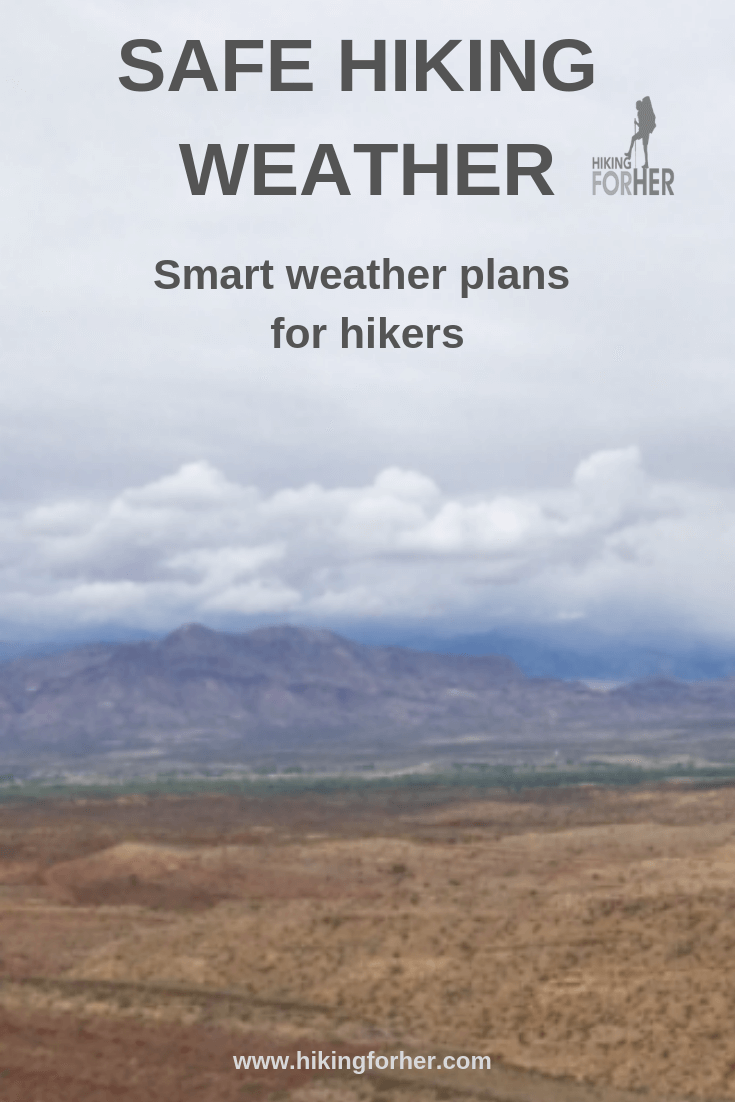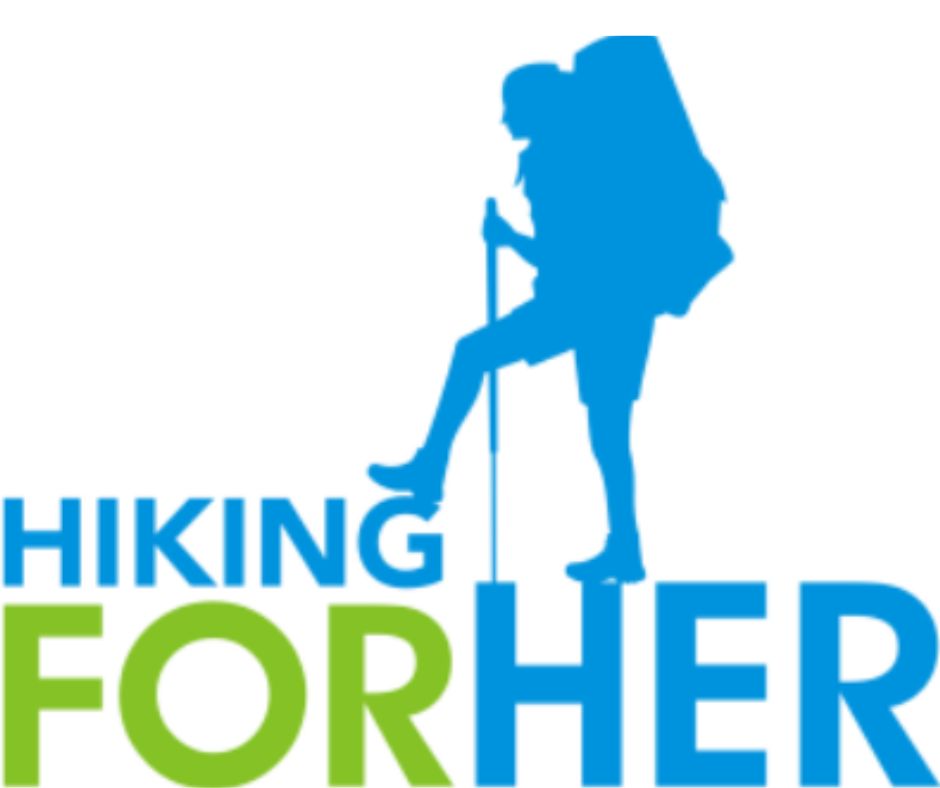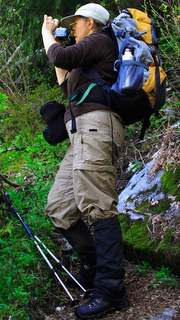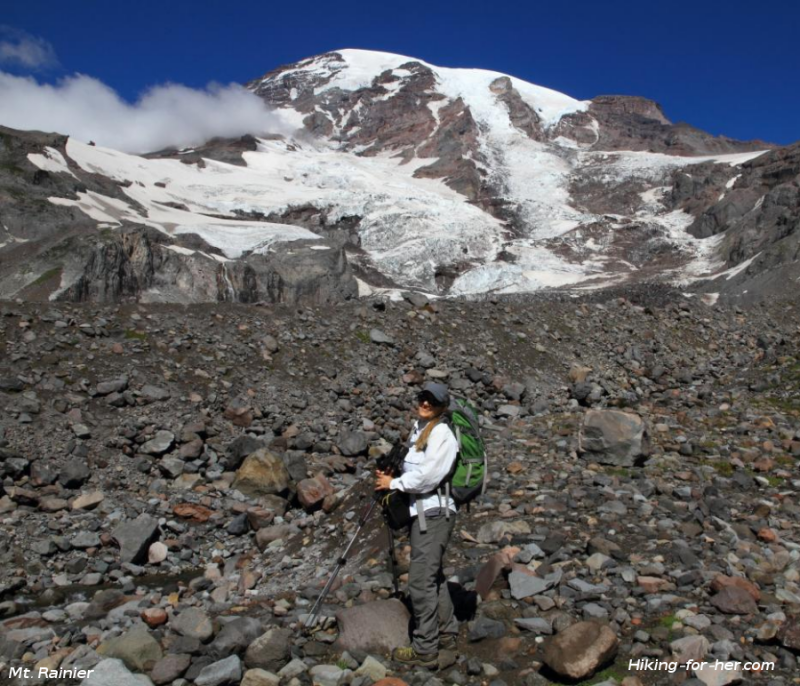Enjoy Happy Trails, the free monthly newsletter from Hiking For Her
Receive a free resource: "Hiking Layering System Explained"
Safe Hiking Weather:
Know What It Looks Like
By Diane Spicer
Safe hiking weather is tied to your comfort zone.
The best hiking weather means you're safe and happy (an ideal day on the trail).
So here's a question for you!
What is your
ideal hiking weather?
Safe hiking weather and perfect hiking weather are very much alike:
- blue skies,
- puffy white clouds,
- a gentle southerly breeze,
- and plenty of daylight to spend on the trail.
Ah! Perfection!
Unfortunately, those days are few & far between in the Pacific Northwest, my stomping grounds.
Gray drizzle, or wind, or low scudding clouds obscuring the mountains are more likely (you KNOW Mt. Rainier is right over there, but haven't seen her in days).
In your neck of the woods, you may run into thunderstorms every afternoon in the summer (Rocky Mountains), or sudden snow squalls at high elevation year round.
High winds, lightning, punishing humidity, flash flooding, sudden temperature swings... hiking safety can get dicey on the trail wherever you hike.
That's exactly why it pays to know how to hike safely through any kind of weather pattern.
Make a weather plan
There are things you can do before you leave home to maximize the chances of a safe hike.
And there are things you can do during a hike to thwart Mother Nature's wrath.
Let's start with some proactive safe weather plan strategies.
Check the weather forecasts
before you hit the trail
One of the best habits a hiker can form is to check the NOAA website for the probability of safe hiking weather, prior to hitting the trail.
- NOAA = National Oceanic & Atmospheric Administration
I highly recommend looking at this weather site the day before, and the morning of, your hike to give yourself the best shot at safe hiking conditions.
This is especially true when seasons are turning and unstable weather patterns are expected to occur.
The beauty of this site, beyond its reliability and accessibility, is that you can type in the location of your hike and get a local forecast. (NOTE: North America only)
Even more safe hiking weather information, too:
- You can check satellite images of the area.
- You can see weather alerts for extreme conditions such as wind, heat, and storms.
And you can get even geekier!
Check out these options while you're on the NOAA site:
- wind speed charts
- cloud cover projections over a 24 hour period
- precipitation forecasts that show you 24 hours of likely hiking weather conditions
Can you see how all of this data helps you plan the type of hike you want?
Example:
If you're a photographer + hiker looking to score a big vista, and the cloud cover is predicted to be 80% all day, maybe you should plan a different hike.
Proactive hiking habit
Bookmark the NOAA site, and make it a habit to consult it before each hike.
And if you're going to stay out for longer than just a day hike, FOR SURE you should be checking on developing weather conditions.
This is especially important during unstable times of year: spring & fall come to mind in the Midwest, or summer monsoons in the Southwest United States.
If you're a snowshoer, you'll want all of the weather information you can get, including avalanche conditions.
More good weather websites
to check
Use windy.com to get forecasts you can watch as the models play out in front of your eyes.
Quite fascinating!!
Here's one more: Mountain Forecast. It's a global resource.
During your hike
Once on the trail, you're on your own in terms of hiking weather safety.
There's not much you can do to change the weather.
But you're not a sitting duck for disaster.
How often do you pay attention to the sky when you hike?
On your next hike, try this:
- Pay attention to what Mother Nature is up to as you hike along.
For example, a sudden burst of wind that blows off your hat means a pressure system is passing through, possibly bringing trouble in its wake.
This should lead you to ask yourself:
More trail clues to
safe hiking weather
Another environmental clue to safe hiking weather that you can use on the trail:
- animal and bird behavior.
Have you ever noticed that the trail gets very quiet before an impending thunder storm?
There's very little cross chatter from the birds, and the small mammals make themselves scarce.
When it gets that quiet, you should think about taking cover, or be ready to cover up quickly.
The best defense against wet weather any hiker has is to be prepared.
Here's how
Carry appropriate rain gear: waterproof jacket & pants, gaiters, hat, and glove covers.
Have them handy in an outside pocket of your backpack so you don't waste precious time digging around when you need to stay dry.
It's also a bummer if your other gear (and sandwiches) gets wet as you scramble to find your rain clothing.
You see what I'm getting at,
right?
Use your knowledge of safe hiking weather to size up the situation and take immediate action to ensure your safety.
Another hiking weather example:
If you're at higher elevations, you need to be prepared for sudden precipitation - including snow- year round. Watch the skies and know when to take cover (if there is any).
Or turn around earlier than planned to ensure your safety.
- More high altitude hiking tips here.
True story:
- I've been caught in snow in June, July AND August, and if I hadn't been prepared, I'd have been miserable, or hypothermic.
- I've also baked on exposed terrain when in a sudden development, the weather turned hot.
But I hiked safely through it all, using the tips and links I've shared on this page.
Humor helps
If you like to hike in dense forest, the weather may be a little hard to read - that's why the forecast (previously discussed) is so important.
My advice?
If you feel raindrops on your hat, it must be raining :)
(Sometimes a sense of humor is needed to endure hiking weather challenges.)
Know where
good hiking weather comes from:
meteorology
A hiker should be motivated to learn more about meteorology (the study of the ocean of air surrounding Earth).
It's the best way to understand what safe hiking weather conditions look like, and how to prepare for changes.
Not really a do-it-yourself person?
A fabulous company called The Teaching Company ferrets out the best college professors, and records them giving lectures.
Their Meteorology series has 24 lectures in all, 30 minutes each.
There's a booklet which summarizes the main points of each lecture, too.
It's a great way to incorporate weather preparedness in your hiking plans.
Tip:
- Invest 30 minutes per week over the winter, and you'll be all set to hit the trail in safety when spring rolls around.
Become a dedicated sky watcher,
day and night
Seriously, you need to watch the sky, read the wind, and learn what cloud types mean to stay as safe as possible while hiking.
I've learned that high clouds don't usually bring trouble right away, but watch out for those low scudding clouds developing on the horizon.
Clouds can tell you a lot about what's going on in the atmosphere, and what it holds in store for you as a hiker.
Ever hear of Tristan Gooley? His website Natural Navigator has tons of weather lore, including this page where you can see cloud photos and learn whether or not those old sayings you've heard (red sky at night...) are true.
Or not!
Clouds are clues to
safe hiking weather
Aren't clouds fascinating? So many questions...
- How do they form?
- What do they say about approaching weather systems?
- Do they promise safe hiking weather, or storms?
I found lots of answers about safe hiking weather in books by Richard Hamblyn.
My current favorite gives an incredible amount of information packed into a small space, and you gotta love the title, right?
The best part?
The best part of this book is the color photos.
I must admit, I never realized how many
types of clouds there are.
And who knew they had elaborate names such as "altocumulus stratiformis"?
And even better: "cirrus spissatus cumulonimbogenitus"!
If you can cram all those words into your skull, there's no stopping you in the quest for safe hiking weather!!
Seriously, the photos alone are worth the price of the book.
Tormenting your friends & neighbors with those absurdly long words: optional fun.
His other books are worth a look, too. Seems he's a bit of a weather geek.
 Safe hiking weather includes cirrus, or what I like to call "swirly" clouds
Safe hiking weather includes cirrus, or what I like to call "swirly" cloudsIf you're really into cloud images, this sequence illustrates how to read changing cloud patterns.
In wet weather,
here's the safety question
Repel, or resist?
Don't wait to get caught in a downpour to learn the difference between these terms:
- water repellent
- water resistant
- water proof
Practice avoidance behavior
You also want to avoid getting your entire hiking backpack wet, so carry a pack cover.
Some day packs come equipped with them.
For instance, each of my Deuter packs has a rain fly tucked into a zip pocket on the bottom of the pack. The brightly colored cover, made of water repellent fabric, is tethered to the pack so it can't blow off or get lost when I set the pack down.
You can buy a pack cover from an outdoor retailer, and I highly recommend that you do so and carry it on every hike, regardless of season.
Or you can go the "garbage bag" route.
- Be sure you carry more than one bag because they snag and rip open.
- Use the the heavy duty variety.
- Duct tape wrapped around a water bottle will help with field repairs.
A hiking umbrella might also be a trailworthy piece of gear for you, rain or shine!
Bottom line
on safe hiking weather?
OK, class, what's the take home message on safe hiking weather?
All together now:
Don't let less-than-ideal weather keep you inside!
Just be smart about hitting the trail. Now you know how!
And be flexible.
Let go of your opinion that there is a best hiking weather window during the year!
Fair weather hikers miss out on some great experiences.
A handful of my most memorable animal encounters have been on rain
hikes, probably because the big mammals didn't expect humans to be
roaming around in the rain.
Believe me when I tell you that with the proper gear, and most importantly, the proper attitude, you can hike in all 4 seasons through everything Mother Nature throws at you!
- Smile, optional
So do yourself and your trail buddies a big favor:
- Read up on safe hiking weather, using the links on this page.
Because if Mother Nature cannot catch you by surprise, your hiking trips will be safer, warmer and drier.
- Not to mention more frequent!
Bonus: cloud watching is very relaxing (until the hail hits).
Have your best hiking rain gear handy ;)
Safe Hiking Weather

